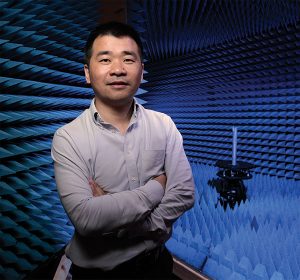
Meta-skin suppresses scattering microwaves, hides objects from radar detection
Two professors in electrical and computer engineering have made significant headway in an innovative stealth technology.
Liang Dong, an associate professor who researches micro-nanofabrication, liquids and polymers, and Jiming Song, a professor who studies electromagnetics, have combined their areas of expertise to create a flexible, stretchable meta-skin material that can render an object virtually undetectable by radar.
The meta-skin is made of metamaterials, or man-made materials that have properties not found in nature. These materials include an array of split ring resonators (SRRs) embedded in layers of silicone sheets. The resonators are filled with the liquid metal alloy galinstan and create small, curved segments of liquid wire that can absorb radar waves.
The researchers stretched multiple layers of the meta-skins along the surface of an object in a planar direction while also changing the spacing between the meta-skin layers in a vertical direction to trap microwaves and reduce the reflected portion of the waves.
“Within our microwave testing chamber, we have successfully demonstrated a cloaking effect when we wrapped the meta-skin around a dielectric cylindrical rod,” says Dong. “We saw a suppressed scattered field, which is an improvement from the more traditional technologies in place that only reduce backscattering.”
These tests showed radar suppression was about 75 percent in the frequency range of 8–10 gigahertz.
While these advancements have fairly obviously applications for the military, the researchers also want to look at how to put this technology to use within different fields such as biomedical devices. They say they may be able to improve implanted medical devices that should not be exposed to microwaves or other electromagnetic waves.
Not to mention the possibility of creating a true invisibility cloak.
“We’ve seen that we can suppress microwaves, so we are now focusing on how to apply that same understanding to manipulate shorter wavelengths such as terahertz electromagnetic waves,” Dong said.
The current resonators can be tuned to absorbed different frequencies up to 9.15–12.38 GHz. Setting sights on shorter wavelengths could bring about more exciting cloak applications. “While this sort of technology would require new structures and design elements, we realize the potential is there to create it,” Dong says.
“This project started as a conversation about doing something interesting with wearable films, and we are excited about the results we’ve seen so far. We are looking forward to taking this concept to the next level.”